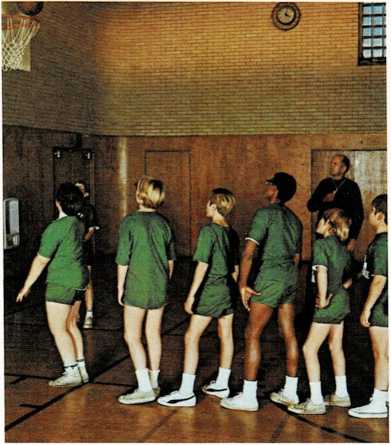The preteen’s health

Height and weight
Usually during the period from 8 to 13, major physical changes start to
occur in a child’s body. The most obvious change is a rapid increase in
height and weight. In girls, this growth spurt usually begins between
the ages of 11 and 14. Girls may continue growing until they are 17 or
18 years old. Boys start their rapid increase in height and weight
somewhat later, usually between 12 and 16 years of age. Since their
growth spurt is usually greater, and since it contin-

Girls hit their growth spurt earlier than boys, a fact that shows up
at school dances.
ues until their early 20’s, most of them catch up and pass the girls in
size by the end of high school. For more information, see
[Growth] in For Special Consideration.
Other signs of maturity
Other signs of maturation usually accompany the increase in height and
weight. There are changes in body contours and development of secondary
sex characteristics. In girls, the leggy, straight-up-and- down
appearance changes to a more rounded figure. This change in body contour
is due to the settling of body fat over the hips, thighs, and chest;
widening of the pelvis; and development of the breasts.
The changes in the body contour of a boy are due to an increase in
muscle strength in his arms and legs, broadening of his shoulders, and
an increase in the size and structure of his skeleton.
Sex development in girls
Secondary sex development in girls usually begins with the development
of the breasts, starting with an enlarging of the nipples and then a
gradual increase in the size of the breasts. At this time your daughter
may become interested in brassieres— because “everyone else is wearing
one.” If your daughter is an early developer, or if she is a late
developer, the best rule of thumb to follow in this matter is, “Are her
girlfriends wearing them?” If they are and she is not, she will most
likely feel left out.
Soft, downy pubic hair—which later darkens and coarsens—is the next
stage of sex development. Growth of hair under the arms follows the
growth of pubic hair.
The first menstrual period usually occurs about the time of underarm
hair growth. This may be preceded by several months of vaginal
discharge, which may be blood- tinged. For the first year or two,
periods may be irregular because the development of the ovum (egg) and
ovulation (the release of eggs) occur irregularly. Almost all girls have
their first period between ages 11 and 15.
Menstruation occurs because of interaction between the ovaries and the
pituitary gland. When menstrual bleeding stops, the ovaries release
hormones called estrogen into the bloodstream. Estrogen causes rapid
growth of the inner lining of the uterus. When estrogen is released, the
pituitary gland releases a hormone called FSH.
FSH increases the production of estrogen and also causes an egg to begin
ripening in an ovary. As the egg ripens, the ovaries secrete other
hormones called progesterone, which also help build the lining of the
uterus. When progesterone is released, the pituitary gland releases a
hormone called LH. When the ratio of FSH to LH reaches a certain point,
the egg is released. If the egg is not fertilized, the ovaries stop
making estrogen and progesterone. Without these hormones, the lining of
the uterus breaks down, causing menstrual bleeding. (For more
information, see [Menstruation] and [Vaginal
discharge]{.smallcaps}cal Guide.)
Sex development in boys
Secondary sex development in boys begins with an increase in the size of
the penis and testicles, accompanied by a growth of pubic hair. Hair
appears next under the arms, and then on the face. About the time hair
starts to grow under the boy’s arms, there is a change in the tone of
his voice. First the voice may break, alternating between high and low
tones. Then it gradually deepens.
When the pubic hair becomes coarse and curly, the boy usually begins to
produce sperm. Sperm are produced continuously in the testicles.
Sometimes, the accumulated sperm and other secretions are discharged in

The unpredictable growth spurt of the preteens results in children of
many sizes and shapes.
a nocturnal emission (a wet dream). Explain to a boy that this may
happen. Otherwise its occurrence may frighten him, or—since it is
usually accompanied by sexual fantasies during sleep—it may leave him
with undeserved guilt feelings.
Dental care
Primary-grade children were conspicuous when they smiled because of the
spaces in their mouths where their primary teeth had fallen out. Many
preteens who smile are conspicuous because of the braces they wear to
help straighten their permanent teeth.
After the six-year molars have fully erupted, your dentist should
examine your child’s teeth for irregularities. Some
irregularities—protruding front teeth, too much space between
teeth—cannot be corrected without braces. Your dentist will probably
suggest an orthodontist (a dentist who specializes in coiTecting
irregularities of the teeth) to apply this treatment.
Although many children dislike wearing braces, the results are well
worth the inconvenience and possible embarrassment to them—and the
cost to you. (For more on this subject, see [Braces,
dental,] and [Malocclusion]{.smallcaps}cal
Guide.)

